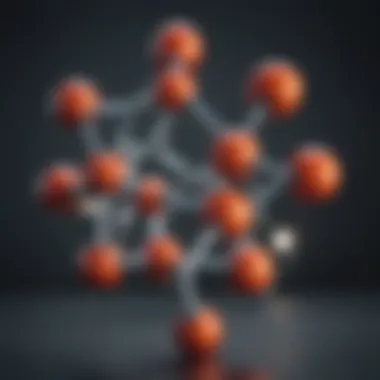Amantadine for Brain Injury: An In-Depth Review


Intro
Amantadine is primarily known as an antiviral medication. However, its role in neurology has garnered considerable attention in recent years. Researchers and clinicians begin to explore its potential in treating brain injuries. Brain injuries occur from trauma, stroke, and infections, among other causes. The ability of amantadine to protect and enhance neurological recovery could provide new hope for patients.
This article reviews the pharmacological properties of amantadine, its clinical applications, and the research surrounding its use in brain injuries. By understanding the mechanisms by which amantadine function, both clinicians and researchers can better evaluate its efficacy and propose future directions in treatment.
Research Overview
Summary of Key Findings
The exploration of amantadine's efficacy in brain injury treatment reveals several important points:
- Amantadine acts as a dopaminergic agent, enhancing neurotransmitter release.
- Studies indicate positive outcomes in patients with traumatic brain injuries.
- The medication shows potential for improving cognitive functions, attention, and overall recovery.
Research indicates that amantadine may not be a one-size-fits-all solution. Different brain injury types might respond variably to treatment. This variability necessitates further studies to clarify its effectiveness across different populations and conditions.
Research Objectives and Hypotheses
The primary objective of this research is to assess amantadine’s effectiveness in patients with brain injury. Specific hypotheses include:
- Amantadine significantly improves recovery rates compared to placebo.
- Patients with severe traumatic brain injuries will show more pronounced benefits.
- The long-term cognitive improvement will correlate with earlier administration of amantadine.
Methodology
Study Design and Approach
To investigate these hypotheses, a mixed-method study design combines quantitative and qualitative approaches. Randomized controlled trials (RCTs) dominate the quantitative aspect. Here, researchers could compare recovery outcomes between groups receiving amantadine and those receiving placebo. Additionally, qualitative interviews with patients and healthcare providers may provide insight into treatment experiences and perceptions.
Data Collection Techniques
Data collection methods will involve various strategies:
- Standardized assessment scales to gauge cognitive functioning and overall recovery.
- Surveys distributed to patients post-treatment to collect feedback.
- Case studies that explore individual patient responses to amantadine in detail.
Prologue to Amantadine
Amantadine is gaining attention in the medical community for its potential role in treating brain injuries. Understanding its use is crucial as it presents a possible therapeutic option that could improve recovery outcomes. The exploration of amantadine involves not only its origins and effects but also the mechanisms that drive its efficacy in this context.
Overview of Amantadine
Amantadine is primarily recognized as an antiviral medication initially used to treat influenza. However, over the years, its neuroprotective properties have sparked interest for applications beyond its original purpose. The dual functionality of amantadine, acting on both viral infections and neural pathways, highlights its unique positioning in pharmacological discussions.
Historical Background
The drug was first approved for medical use in the 1960s. Since then, a number of studies have explored its impact on various neurological conditions. Despite its success in treating influenza, the shift towards studying amantadine for brain injuries marks a noteworthy evolution in its application. This has prompted further investigation into its therapeutic potential especially in the aftermath of traumatic events, such as concussions and strokes.
Mechanisms of Action
At its core, understanding amantadine's effectiveness in brain injury management requires a look at the biological mechanisms it influences. Two primary interactions are often discussed:
NMDA Receptor Modulation
NMDA receptors play a pivotal role in synaptic plasticity and memory function. Amantadine's ability to modulate these receptors means it can potentially reduce excitotoxicity during brain injury. This quality is significant because excessive stimulation of NMDA receptors can lead to neuronal damage. By acting as an antagonist in certain contexts, amantadine may help protect neurons during periods of high excitability.
The key characteristic of NMDA receptor modulation is its ability to balance the excitatory signals in the brain. For patients suffering from brain injuries, this modulation could prevent further neurological harm, making it a compelling choice for treatment. One specific advantage of focusing on NMDA receptor modulation is its potential to enhance cognitive recovery processes in patients.
Dopaminergic System Interactions
Amantadine also influences the dopaminergic system, which is essential in motor control and several neurocognitive functions. By enhancing the release of dopamine, amantadine can alleviate symptoms related to reduced dopaminergic activity often associated with brain injuries. This is particularly relevant for those who may experience mobility issues or cognitive impairment after an injury.
The pivotal aspect of dopaminergic system interactions is its connection to the overall motivation and behavior of individuals. For patients, restoring dopaminergic function can improve both physical recovery and quality of life. A unique feature of this interaction is amantadine's ability to provide symptomatic relief without triggering excessive dopamine-related side effects, which often complicate treatment.


"Understanding the multiple action mechanisms of amantadine is essential for appreciating its role in brain injury recovery."
In summary, the exploration of amantadine's mechanisms reveals a complex interplay that offers promising avenues for treating brain injuries. Its capability to modulate NMDA receptors and interact positively with the dopaminergic system establishes it as a potential breakthrough in the field of neurorehabilitation.
Types of Brain Injuries
Understanding the different types of brain injuries is crucial for evaluating the effectiveness of amantadine as a treatment option. Brain injuries can be broadly categorized into traumatic and acquired injuries. Each category presents unique challenges and considerations that influence treatment approaches and outcomes. By examining these types, we can better grasp the role of amantadine in the clinical setting.
Traumatic Brain Injury
Traumatic Brain Injury, or TBI, occurs when an external force impacts the head or body, leading to damage in brain function. This type of injury can result from falls, vehicle accidents, or sports-related incidents. It is critical to recognize that TBI encompasses a spectrum of severity, from mild concussions to severe blunt force trauma. Symptoms of TBI can include confusion, memory loss, and severe headaches.
Key Points:
- Acute Management: Initial treatment for TBI often includes monitoring and preventing secondary brain damage.
- Recovery Process: Recovery may involve rehabilitation therapies, which can be enhanced with pharmacological interventions like amantadine.
- Research Insights: Several clinical trials have indicated that amantadine may improve recovery times and cognitive outcomes in patients suffering from TBI.
Acquired Brain Injury
Acquired Brain Injury, or ABI, refers to brain damage that occurs after birth. Unlike TBI, ABI is typically due to internal factors such as stroke, infections, or tumors. The implications of ABI are diverse, particularly since different underlying causes lead to various symptoms. Brain function can be disrupted because of cellular damage or loss of blood supply.
Considerations:
- Diagnosis and Treatment: Accurate diagnosis is important for effective treatment. Various imaging techniques like CT scans and MRI are used to assess the extent of injury.
- Amantadine's Role: In patients who have ABI due to stroke, for example, amantadine may assist in cognitive recovery and motor function, which enhances overall rehabilitation efforts.
Stroke-Induced Brain Injury
Stroke-Induced Brain Injury encompasses the damage caused when blood flow to the brain is interrupted, leading to cellular death. This can be due to ischemic strokes, where blood clots block vessels, or hemorrhagic strokes, where bleeding occurs in or around the brain. The effects of a stroke can be profound, impacting mobility, speech, and cognition, depending on the area of the brain affected.
Importance of Treatment:
- Immediate Intervention: Quick medical attention is critical to minimize damage and maximize recovery potential.
- Long-term Monitoring: Post-stroke rehabilitation typically includes various therapies aimed at restoring function, where amantadine’s neuroprotective effects may provide additional support.
- Current Research: Ongoing studies explore the efficacy of amantadine in stroke recovery, suggesting potential improvements in functional outcomes for these patients.
"Understanding types of brain injuries helps in tailoring appropriate treatment strategies. This is particularly relevant when considering the introduction of amantadine into rehabilitation protocols."
Clinical Applications of Amantadine
The clinical applications of Amantadine are critical in understanding its potential benefits for individuals suffering from brain injuries. This section dives into its use in different clinical scenarios, highlighting specific cases such as traumatic brain injury, stroke rehabilitation, and neurodegenerative diseases. Understanding these applications helps both clinicians and patients assess the therapeutic value of Amantadine and enhances existing treatment protocols.
Use in Traumatic Brain Injury
Clinical Trials
Clinical trials involving Amantadine are pivotal for establishing its efficacy in treating traumatic brain injury (TBI). One key aspect of these trials is their design, including controlled environments and proper evaluation criteria. They often focus on measuring cognitive recovery, motor function improvement, and overall patient quality of life.
These clinical trials are respected because they provide a reliable data source to confirm how well Amantadine works for TBI. The unique feature of these trials is their ability to adapt based on evolving research. However, they sometimes have limitations like sample size and duration.
Patient Outcomes
The examination of patient outcomes post-Amantadine treatment is a critical component of evaluating its effectiveness. Here, the focus is on functional recovery scores and neurological assessments as indicators of progress. Many studies show that patients experience improved attention span and motor skills.
What makes these outcomes significant is their practical implications for daily life activities. One advantage is that improved patient outcomes can lead to shorter recovery times. However, the extent of improvement can vary widely due to individual patient factors.
Use in Stroke Rehabilitation
Effects on Recovery
In the context of stroke rehabilitation, the effects of Amantadine on recovery are noteworthy. This particular application centers on how the drug impacts motor function and cognitive rehabilitation in stroke survivors. Several studies highlight that Amantadine use can enhance recovery rates in patients experiencing fatigue, which is a common symptom after a stroke.
The key characteristic of these effects is their potential to result in quicker restoration of independent living skills. However, some patients may still show limited responses, which highlights the need for tailored treatment plans.
Current Research Findings


Current research findings related to Amantadine in stroke rehabilitation provide essential insights into its effectiveness. Recent studies reveal that alongside traditional treatments, Amantadine may help improve outcomes. This dual approach is gaining traction among rehabilitation professionals.
The advantage of these findings lies in their potential to extend treatment options for stroke patients. However, ongoing research is crucial to understand long-term effects and the best methods for integrating Amantadine with other therapies.
Potential in Neurodegenerative Diseases
Parkinson's Disease
Amantadine shows promise in treating Parkinson’s Disease, primarily by alleviating symptoms such as tremors and rigidity. This application is significant in mitigating some side effects associated with dopaminergic therapies, which are often used in treating this condition. Studies indicate that Amantadine can lead to improvement in daily functioning for patients.
The key benefit of using Amantadine is its versatility within broader treatment regimens. Yet, there are disadvantages, such as varying effects among patients influenced by disease progression and treatment history.
Alzheimer's Disease
Regarding Alzheimer’s Disease, Amantadine is under investigation for its potential to improve cognitive functions. Researchers are examining whether Amantadine can slow cognitive decline in Alzheimer’s patients. Early results suggest it may help in certain cases, but research is still ongoing.
The unique aspect of Alzheimer’s treatment is its complexity, which demands a multifaceted approach. While the initial findings are promising, it is crucial to balance expectations with the reality of Alzheimer’s progression, emphasizing the need for continued research.
"Amantadine has shown potential in various brain injury contexts, bridging the gap between traditional and modern treatment approaches."
Efficacy of Amantadine in Brain Injury
The efficacy of amantadine in treating brain injuries has gained significant attention in recent years. As medical professionals and researchers continue to explore treatment options for patients with traumatic brain injuries and other forms of neural compromise, understanding how amantadine may improve outcomes is critical. The examination of its effects not only spans various types of brain injuries but also encompasses a range of therapeutic benefits and potential limitations.
Amantadine, once recognized primarily for its antiviral properties, has shown promise in enhancing cognitive function and physical recovery in brain injury cases. Its modulation of neurochemical pathways can lead to improved motor function and cognitive processes. This makes the efficacy aspect essential for evaluating amantadine's overall role in treatment protocols and patient care. Key elements worth examining include patient response rates, duration of treatment effects, and specific neurological improvements experienced by individuals receiving this medication.
Review of Key Studies
Several pivotal studies have investigated the efficacy of amantadine in the context of brain injuries. For instance, a notable randomized controlled trial highlighted improvements in motor scores and cognitive assessments among patients who received amantadine compared to those on placebos. The trial demonstrated that after 14 days of treatment, statistically significant enhancements in both physical mobility and attentiveness were observed. Outcomes like these underscore the medication's potential as a valuable addition to rehabilitation strategies.
Another essential study involved patients recovering from severe traumatic brain injuries. It found that amantadine not only helped reduce agitation but also promoted earlier functional recovery at discharge. Patients on amantadine exhibited greater independence in activities of daily living, suggesting a highly beneficial impact on recovery trajectories.
In summary, the gathered data indicates that amantadine can be effective in addressing both cognitive and physical deficits associated with brain injuries. As studies continue, the emerging consensus seems to advocate for its inclusion in comprehensive rehabilitation frameworks.
Comparative Studies with Other Treatments
When evaluating the efficacy of amantadine, it is essential to place its impacts in the context of traditional treatments. Studies comparing amantadine with established therapies, such as physiotherapy and cognitive behavioral interventions, present insightful findings. Such comparative analyses help to elucidate where amantadine may fill gaps in treatment strategies that other methods cannot address alone.
For example, certain studies have posited that while physiotherapy is critical to physical rehabilitation, adding amantadine can potentiate the overall recovery process. The combination of physical exercises and neuropharmacological support catered specifically to brain injury cases proves to enhance patient outcomes more effectively than either approach alone.
Further, by examining cases of neuropsychological therapy alongside amantadine administration, researchers have noted improvements in attention span and emotional regulation when both methods were utilized simultaneously. However, it is also prudent to consider that not all patients may respond positively to amantadine, and understanding individual differences remains a challenge.
Moving forward, continued research is necessary to establish clearer guidelines on how amantadine might serve in synergy with other therapeutic modalities. As the evidence base expands, these insights will help clinicians make informed decisions about integrating amantadine into treatment plans for patients recovering from brain injuries.
Safety and Side Effects
Understanding the safety and side effects of Amantadine is crucial when considering its use for brain injuries. As with any medication, the benefits must be weighed against the potential risks. Proper management of these side effects can enhance patient outcomes and ensure the medication is used effectively. In this section, we will explore common side effects associated with Amantadine and outline important contraindications and precautions that healthcare providers should consider.
Common Side Effects
Amantadine is generally well tolerated, but some patients may experience side effects. The most common side effects include:
- Nausea and vomiting: These symptoms may occur, particularly when treatment begins. They often resolve as the body adjusts to the medication.
- Dizziness: Patients may feel lightheaded or unsteady, which can be distressing, especially in individuals recovering from brain injuries.
- Insomnia: Sleep disturbances are reported by some users. This can be problematic for individuals who already struggle with sleep due to their injuries.
- Dry mouth: This side effect may lead to discomfort. Staying well-hydrated can help alleviate this issue.
- Anxiety and nervousness: Some individuals might experience increased feelings of anxiety.
While these side effects are common, they can significantly impact a patient’s quality of life. It is essential for healthcare providers to monitor their patients for these symptoms and discuss any concerns that arise.
Contraindications and Precautions
There are specific situations where Amantadine should be used with caution or avoided entirely. Important contraindications include:
- Hypersensitivity: Any known allergy to Amantadine or its components is a clear contraindication. This includes individuals who have had severe allergic reactions in the past.
- Renal impairment: Patients with compromised kidney function may require dosage adjustments. Amantadine is primarily excreted through the kidneys, and impaired function can lead to toxicity.
- History of seizures: Caution is advised in patients with a history of seizure disorders, as Amantadine can lower the seizure threshold.
- Pregnancy and breastfeeding: The safety of Amantadine during pregnancy and lactation is not fully established. Pregnant women should only use it if clearly needed.


Precautions also include monitoring for interactions with other medications. Amantadine can interact with anticholinergic drugs and certain other neurological agents. A thorough medication review is necessary to prevent adverse reactions.
In summary, while Amantadine offers promising benefits for brain injury treatment, understanding its safety profile is essential. Addressing side effects and contraindications ensures that healthcare professionals can provide the best care possible, tailoring treatment to each patient's unique needs.
Comparative Analysis with Traditional Treatments
Understanding the comparative analysis of Amantadine with traditional treatments is crucial for several reasons. First, it allows practitioners to evaluate the effectiveness of newer pharmacological options against established therapies. This analysis aids clinicians in making informed decisions tailored to the specific needs of patients suffering from brain injuries. Moreover, by considering various treatment modalities, healthcare providers can optimize recovery pathways for patients.
Amantadine offers promise due to its dual role as a neuroprotective agent and a means to enhance cognitive recovery. Contrasting it with traditional approaches highlights both its unique mechanisms and potential advantages. It is essential to analyze how Amantadine's efficacy in treating brain injury stacks up against established therapies such as physiotherapy and cognitive behavioral approaches.
Physiotherapy and Rehabilitation
Physiotherapy plays a pivotal role in the recovery process for brain injury patients. It focuses on physical rehabilitation to restore mobility, strength, and overall function. Traditional physiotherapy often involves exercises aimed at improving motor skills and coordinating movements. Approaches may include exercises tailored to the patient’s specific deficits, use of assistive devices, and neuromuscular re-education.
Comparatively, Amantadine does not replace physiotherapy; instead, it can complement rehabilitation. By potentially enhancing neural recovery mechanisms, Amantadine may lead to better outcomes when combined with physical therapies. Some studies suggest that patients receiving Amantadine alongside their physiotherapy show greater improvements in functional recovery than those who undergo only traditional rehabilitation methods.
Benefits include:
- Improved motor function.
- Enhanced stamina and physical endurance.
- Increased compliance with rehabilitation protocols.
Cognitive Behavioral Approaches
Cognitive behavioral approaches are essential in rehabilitating brain injury patients. These therapies focus on modifying dysfunctional thought patterns and behaviors. They help patients adapt to their new reality and improve emotional and cognitive functioning. Techniques might include goal-setting, problem-solving strategies, and skills training to foster independence.
Adding Amantadine into the mix may help in cognitive rehabilitation significantly. Given its ability to influence dopaminergic systems, it could support cognitive recovery by enhancing motivation and attention. This interaction can lead to more active participation in cognitive therapies, ultimately contributing to more effective rehabilitation.
Similarities and differences between Amantadine and cognitive behavioral therapies include:
- Amantadine may enhance cognitive function by addressing underlying neurochemical imbalances.
- Cognitive behavioral approaches target the psychosocial aspects of recovery.
- Both methods, when used in tandem, may offer comprehensive support for patients.
The integration of Amantadine with traditional therapies offers a pathway toward a more holistic approach to treatment, emphasizing both physical and cognitive recovery.
Future Prospects of Amantadine Research
The exploration of amantadine in brain injury treatment is gaining momentum. Understanding future prospects is crucial as it directs attention to innovative approaches in patient care. Research advancements can potentially optimize existing treatment protocols and highlight new therapeutic uses for amantadine.
Emerging Studies
Recently, several emerging studies are focusing on the efficacy of amantadine in different injury contexts. Early findings suggest its role expanding beyond neuroprotection to potential cognitive enhancement. In particular, a few studies are looking into amantadine’s application in improving recovery outcomes after traumatic brain injuries. Clinical trials are ongoing to examine its effectiveness in modulating neuroinflammation, a critical factor in brain recovery. Research is also focusing on novel delivery methods to enhance bioavailability in the brain.
The evolving nature of clinical trials can lead to a re-evaluation of treatment protocols and recommendations.
Potential for Combination Therapies
Combining amantadine with other treatment modalities is becoming an intriguing area of investigation. Research indicates that pairing amantadine with rehabilitative therapies may yield improved patient outcomes. Current studies are assessing how it interacts with agents like transcranial magnetic stimulation or cognitive therapies. Such combinations could enhance the overall recovery process and address complex symptoms found in patients with significant brain injuries. Understanding dosing and timing is key for maximizing therapeutic benefits.
Long-term Implications for Treatment Protocols
Long-term implications of amantadine use in treating brain injuries are still unfolding. As more research emerges, insights into its long-term safety and efficacy will inform treatment protocols. Future treatment guidelines may incorporate amantadine not only for its immediate benefits but also for its potential role in long-term cognitive rehabilitation and functional recovery. New findings could lead to the formalization of protocols that integrate amantadine with other therapeutic strategies, thus providing a more holistic approach to brain injury treatment.
End
The significance of the conclusion in this article lies in its capacity to bring together the various threads woven throughout the discussions on amantadine and its applications for brain injury. This section encourages reflection on the findings presented and the potential impact of amantadine on clinical practice. It emphasizes an integrated understanding of not just the drug itself, but also its historical context, mechanisms of action, efficacies, and safety, particularly in the realm of treating brain injuries.
Summary of Findings
In synthesizing the content of this article, we acknowledge key takeaways:
- Efficacy: Studies highlighted that amantadine shows promise in improving recovery outcomes for individuals with traumatic brain injury and stroke-related injuries.
- Safety Profile: While common side effects exist, they are typically manageable. Awareness of contraindications and precautions is crucial.
- Potential Applications: Beyond immediate trauma recovery, research hints at prospective uses in neurodegenerative conditions, which could broaden the therapeutic landscape significantly.
These findings provide a solid foundation for further exploration into amantadine’s role in brain injury treatment. They serve to fill current knowledge gaps and inspire additional inquiry, especially within clinical settings.
Final Thoughts on the Role of Amantadine
Amantadine, with its dual nature as an antiviral and a neuroprotective agent, holds a unique position in therapeutic interventions for brain injuries. Its historical emergence as a treatment option is now supported by a growing body of contemporary research, indicating its multifaceted benefits.
Moving forward, the evolving landscape of treatment protocols in neurology may embrace amantadine more widely. Collaborative research efforts can further elucidate its mechanistic contributions to recovery processes, thus enhancing treatment paradigms for brain injury patients.
By fostering an environment that encourages comprehensive studies, stakeholders can pave the way for refined clinical practices that optimize the use of amantadine in various neurological conditions. The implications are vast and warrant ongoing exploration and dialogue.















